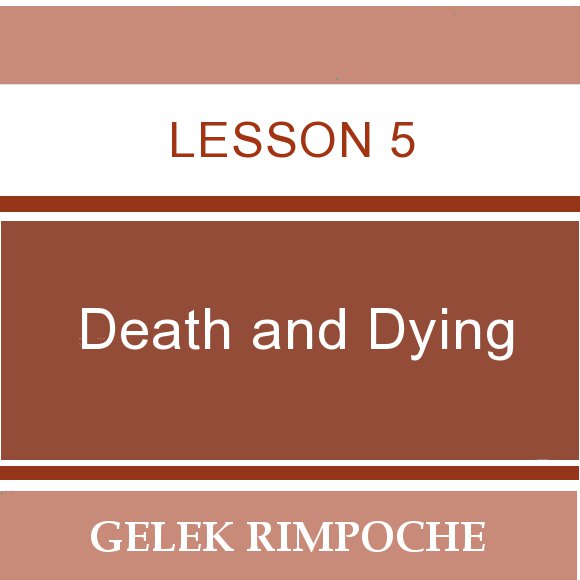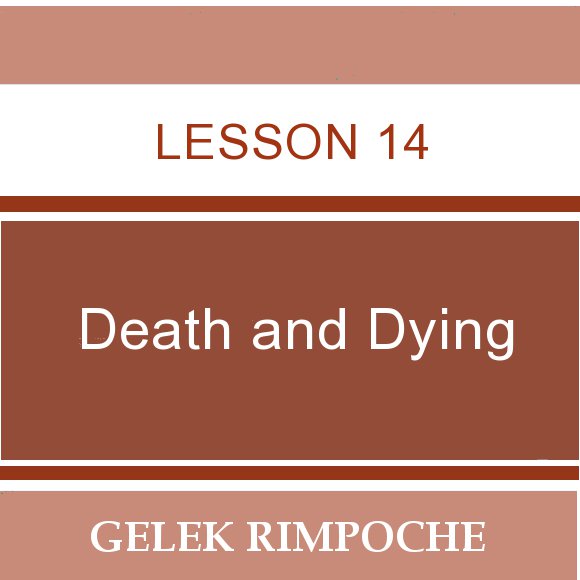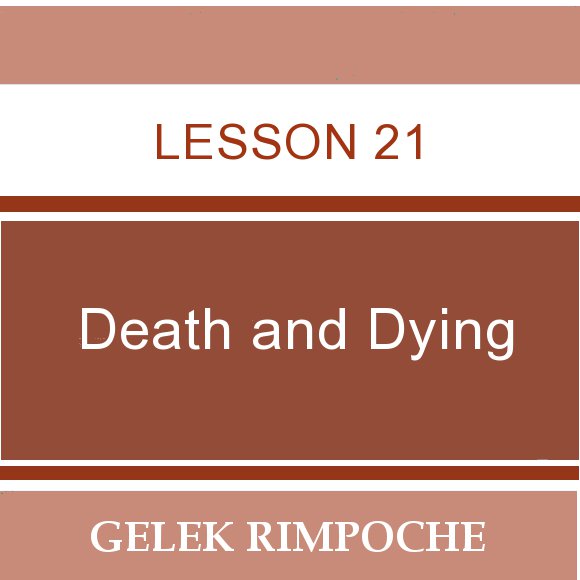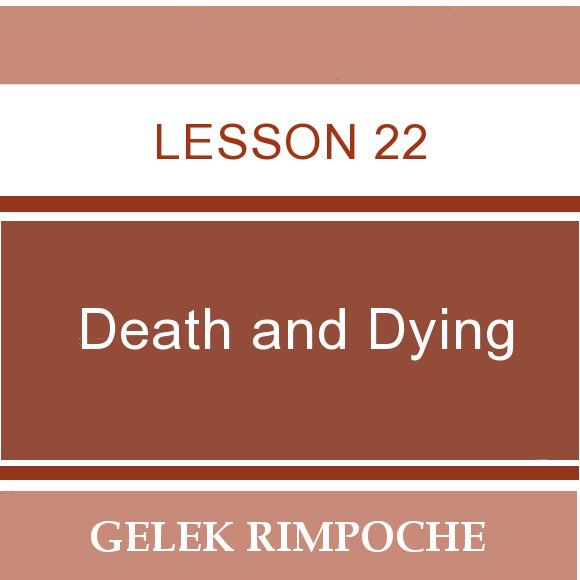Death and Dying


Lesson 1: Death and Dying
Lesson Number 1 of 22
Lesson 1
Why should we think about death and dying right now? In this lesson Gelek Rimpoche explains that now we have the freedom to make choices, so now is the time to help ourselves. By the time death comes it is too late to do anything. Also, if we make wrong choices now this may lead to the loss of our ability to control our own deeds later. Rimpoche says that as human beings we have a great capacity to make positive impacts on our life, right up to reaching nirvana or even total enlightenment.

Lesson 2: Death and Dying
Lesson Number 2 of 22
Lesson 2
In the West we tend to avoid the subject of death. Wouldn’t it be better to learn all we can about the process so that we might have a chance to influence or change what happens during the death and dying process? Gelek Rimpoche introduces the way that our practice, sadhanas and meditation lead us to the Path that provides the opportunity to transform ordinary death, bardo and rebirth into the extraordinary achievement of Dharmakaya, Sambhogakaya and Nirmanakaya: total enlightenment in a single lifetime.

Lesson 3: Death and Dying
Lesson Number 3 of 22
Lesson 3
Gelek Rimpoche gives instructions on how to derive maximum benefit from this and any other teaching. Greatest benefit is derived from the highest level of motivation: that you may become enlightened in order to help all sentient beings become enlightened. The greatest obstacle to this is attachment that protects the ego such as attachment to any personal gain from helping all sentient beings.

Lesson 4: Death and Dying
Lesson Number 4 of 22
Lesson 4
In this lesson Gelek Rimpoche states that the only path that leads to becoming fully enlightened in a single short lifetime is the profound two stages: the development stage and the completion stage of Vajrayana. In the development stage we are training, within the base of our ordinary life, to transform death, bardo and rebirth into the three bodies of Buddha: death-like Dharmakaya, bardo-like Sambhogakaya and rebirth-like Nirmanakaya. In this precious human life we have the conditions and the six elements on which to work to achieve this transformation during the completion stage.

Lesson 5: Death and Dying
Lesson Number 5 of 22
Lesson 5
In this lesson Gelek Rimpoche discusses what happens during the death process to the channels, chakras and energies of the body that are central to vajrayana practice and attainment of enlightenment.

Lesson 6: Death and Dying
Lesson Number 6 of 22
Lesson 6
What happens when a person is dying, in the Buddhist view? In this lesson Gelek Rimpoche begins the explanation of the stages and processes that occur in the body and the consciousness as death occurs. Dying is a process of dissolving. Each part of the dissolving has an external and an internal sign. The external signs tell an individual what is happening by looking at the physical body. The internal signs inform the departing individual what is happening. This lesson covers the first death stage when the dying person perceives the world around them as having a mirage-like appearance.

Lesson 7: Death and Dying
Lesson Number 7 of 22
Lesson 7
In this lesson Gelek Rimpoche describes the second death stage with the internal sign that dying person perceives a smoky appearance, the third death stage with the internal sign of perceiving sparks or fireflies with the smoke and the fourth death stage with the internal sign of perceiving the reflected light of a flickering butter lamp or candle. These four are the stages of dissolving of the elements.

Lesson 8: Death and Dying
Lesson Number 8 of 22
Lesson 8
In this lesson, Gelek Rimpoche discusses the stages of death involving the dissolution of the nature of mind. Following the dissolving of all gross thoughts, the remaining subtle thoughts are referred to as the mind of whitish feeling, the mind of reddish feeling, the mind of darkness and the mind of clear light of death. This lesson covers the mind of radiant white appearance and the mind of radiant red increase.

Lesson 9: Death and Dying
Lesson Number 9 of 22
Lesson 9
In this lesson, Gelek Rimpoche explains the seventh and eighth stages of death: the mind of radiant black near-attainment and the mind of clear light of death. The mind and energies that function during these latter stages after gross level of thought has ceased are at a very subtle level. This period of subtle thought and energies presents a great opportunity.

Lesson 10: Death and Dying
Lesson Number 10 of 22
Lesson 10
This lesson is the first part of a question and answer session. In response to one question, Gelek Rimpoche answers that as a practitioner you may have worked toward enlightenment, but not have attained it during a single short lifetime. This, coupled with many positive deeds to carry from this lifetime, means you will be driven toward a positive rebirth.

Lesson 11: Death and Dying
Lesson Number 11 of 22
Lesson 11
In the continuation of the question and answer session, Gelek Rimpoche
says it is useful to focus on the details of death and our future lives because knowing what may happen during the death process will allow a person the opportunity to do something differently than if they did not know.

Lesson 12: Death and Dying
Lesson Number 12 of 22
Lesson 12
In this lesson Gelek Rimpoche responds to a request for elaboration on his statement that a comfortable, wonderful life can be very expensive. He says each and every comfort costs us our virtue and our merit. That is how they are expensive. Without your virtue you will not enjoy material comforts.

Lesson 13: Death and Dying
Lesson Number 13 of 22
Lesson 13
In what way can this teaching be used to help the dying? In this lesson Gelek Rimpoche answers that focusing on the Guru dissolving to the middle to the central channel brings Clear Light, Illusion Body and Ultimate Enlightenment.
This can be both the Completion Stage leading to enlightenment or using the opportunity afforded by the dying stages to make actual Clear Light rather than base Clear Light, Illusion Body rather than base bardo, and full enlightenment rather than base rebirth into Samsara.

Lesson 14: Death and Dying
Lesson Number 14 of 22
Lesson 14
What can one do who has not reached the non-reversible Path? In this lesson Gelek Rimpoche discusses the Supremely Powerful Method of forcefully obtaining enlightenment that will be explained in detail in later lessons. Alternatively one can strive to cut all sources of attachment and hatred. This can be done through whatever one is practicing, but should be something that is comfortably done under the circumstances. Don’t bite of more that you can chew.

Lesson 15: Death and Dying
Lesson Number 15 of 22
Lesson 15
In response to a question in this lesson on how long one should wait after clinical death to allow harvesting of organs for transplant, Gelek Rimpoche answers that this should only be the choice of the departing person rather than the people left behind. The choice to donate one’s organs for transplant is an act of tremendous generosity. But, there is the question of the person still being in the body after brain death. The consciousness will leave when the body is disturbed. Sometimes this process is hurried too much.

Lesson 16: Death and Dying
Lesson Number 16 of 22
Lesson 16
In this lesson Gelek Rimpoche begin the discussion of the bardo. After the state of Clear Light of Death a bardo body is formed through the same stages as in death only in reverse. The bardo represents a tremendous opportunity for change. Even in bardo, a person can reach the stage of no more learning, and as a result can take rebirth at a higher level.

Lesson 17: Death and Dying
Lesson Number 17 of 22
Lesson 17
In this lesson Gelek Rimpoche describes the process that the bardo being, or bardowa, goes through in the bardo. The bardowa normally stays seven days at most if no perfect conditions are found for rebirth, less if perfect conditions are found and the rebirth takes place straightaway. At seven days the bardowa has a small death with the same processes as initially and then is reborn as a different bardowa. This can take place a maximum of seven times or 49 days in the bardo. This discussion has been done so that we understand the bardo as Sambhogakaya, which will help us to gain an understanding of the pure and impure Illusion Body.

Lesson 18: Death and Dying
Lesson Number 18 of 22
Lesson 18
In this lesson one question that is asked is what part does DNA play in the Buddhist interpretation of karma and reincarnation? Gelek Rimpoche answers that if there is no karmic connection between the parents and the children, rebirth doesn’t take place. DNA would be the physical basis for life. The child should have the karma to receive, use, maintain and manage life. Even if there is no biological relation, there must be a karmic relation for development of a good parent-child relationship.

Lesson 19: Death and Dying
Lesson Number 19 of 22
Lesson 19
In this lesson Gelek Rimpoche responds to the question: If there is something that reincarnates, how does that fit with the concept of no self? He says no self does not mean no existence. Reincarnation does not contradict selflessness or the emptiness of self. Emptiness of self is lack of inherent existence.

Lesson 20: Death and Dying
Lesson Number 20 of 22
Lesson 20
How can the Buddhist view on euthanasia be interpreted in the case of euthanizing your pet that is suffering? In this lesson, Gelek Rimpoche answers that euthanizing a pet that is suffering doesn’t end the suffering of that pet. Many people do that thinking it is helping, but helping whom? It does cut the physical pain and so is helpful in that way. But we don’t know whether the future of that pet will be good or bad. The life can’t be lightly taken.

Lesson 21: Death and Dying
Lesson Number 21 of 22
Lesson 21
In this lesson Gelek Rimpoche begins the teaching on rebirth. Rebirth begins with the karmic relationship between the parents and the one to be reborn. This starts the development of the mind and body. At the heart level of the developing body, the subtle air, the subtle mind and the pure aspects of the egg and the semen (red and white parts, respectively) combine to form the indestructible dot at the center of the central channel. Eventually, at nine months the child is born in the manner we all are familiar with.

Lesson 22: Death and Dying
Lesson Number 22 of 22
Lesson 22
In this lesson Gelek Rimpoche discusses the opportunity of the death, bardo and rebirth process to achieve enlightenment in a single lifetime. The form that is born is the base upon which you work, in both development and completion stages, to reach the Nirmanakaya. Your development practice is to simulate making ordinary death, bardo and rebirth into pure Dharmakaya, Sambhogakaya and Nirmanakaya. In completion stage you use pure Clear Light (Dharmakaya), Illusion Body (Sambhogaka) and the return of Illusion Body to your ordinary body to be reborn as fully enlightened (Nirmanakaya) in a single lifetime.

